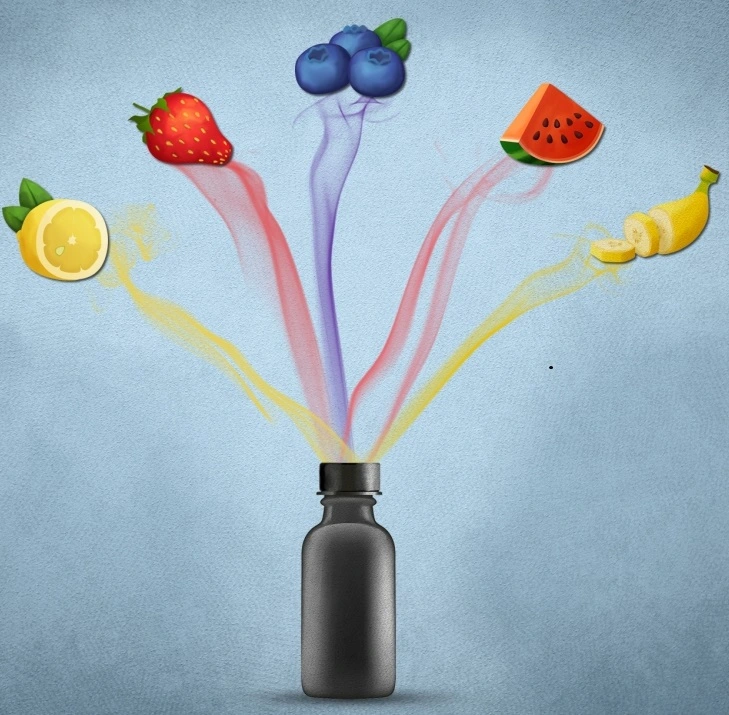Let me tell you the secret of the distinctive taste of international brands ,It’s their mixture of Food flavorings flavorings. learn with us in this article about the flavorings.
Table of Contents
Definition of flavorings
Flavor: It Is the result of the integration of the sense of flavor and smell, resulting from the interaction of food components with the sense of taste and smell and the nervous receptors.
Flavor consists of chemical substances within food that are interacted with through sensory receptors on the tongue and the sense of smell, and are transmitted to the brain to translate these intersecting nerve impulses into distinct flavors. The texture of food plays an essential role, such as softness, roughness, granularity, and viscosity, and Is also affected by the medium In which these compounds are present. If the medium Is hot (spice) or cold (menthol)
Classification of food flavorings and their chemical composition:

Food flavorings are divided into four categories:
They are affected by each other during their interaction In the mouth
- Sugary food flavourings: Sugars and alcohols are artificial sweeteners that are the source of the sweet taste in foods. The degree of sweetening of sugars varies depending on their molecular weight and the position of the hydroxyl chains (OH).
- Acidic food flavours: Molecular compounds containing hydrogen ions are the main responsible for the sour taste. The sour flavor in the mouth varies depending on the nature of the acid and the degree of pH. The most important food acids are asporic acid, maltic acid, and tartaric acid.
3. Salty and bitter food flavorings: The main cause of the salty taste in food Is sodium chloride, and the main purpose of the presence of salts is to highlight the taste of other food flavorings. The composition of the substances that cause saltiness depends on the chemical structure that combines positive and negative ions, noting that the greater the molecular weight of the salts. It gives a bitter taste In the mouth.
Types of food flavorings:
Natural food flavourings present in food composition that give each food Its distinctive taste and smell
Food flavourings are synthesized during the changes that occur to the food substance as a result of the disintegration of amino acids and sugars and the synthesis of new compounds that give a new flavor to the food product, which occurs either as a result of heat, microbial bacteria, chemical changes, or mixing food materials with each other and creating a medium for them to interact with each other (such as the fermentation of cocoa beans). And roasting coffee beans, and ripening baked goods, and fermenting bananas
….)
Artificial food flavorings:
Here lies the secret that distinguishes the products, as new or similar to natural flavor compounds can be created by synthesizing esters, so they are In different forms, either as an oily liquid or as a solid powder.
Forms of nutritional depletions:
Liquid: with a carrier phase of ethanol, glycerin, propylene glycol
Oily: dissolved In vegetable oil or benzyl alcohol
Emulsions: These are emulsions of oil In water
Flavor powder: loaded with table salt, sugar, starch, or a combination thereof
Flavor enhancers: To strengthen flavors in food, auxiliary materials are used that have the task of revealing and harshening flavors, the most important of which is Monosodium glutamate, which is produced from wheat gluten and soy protein and is In the form of a crystalline compound and gives a rich taste.
10 from Flavorings Benefits
1-Improving taste: Food flavorings add a distinctive and delicious flavor to food, enhancing the eating experience.
2-Stimulate appetite: Flavorings may help stimulate appetite and increase the desire to eat, especially in the case of anorexia.
3-Reducing sugar: Flavorings can be used to reduce dependence on sugar in foods and drinks, which contributes to maintaining dental health and reducing calories.
4-Diversify the diet: Flavorings enable you to vary the flavors of foods without having to add large amounts of additional ingredients.
5-Special diet support: Flavorings can be used in weight control diets to improve the eating experience without increasing calories.
6-Improve children’s food tolerance: Flavorings can help make healthy foods more attractive to children.
7-Improve children’s food tolerance: Flavorings can help make healthy foods more attractive to children.
8-Save time in cooking: Flavorings can be used to provide strong flavor without having to use a lot of ingredients or time.
9-Stimulating saliva secretion: Some flavorings help stimulate saliva secretion, which contributes to the digestive process.
10-Reducing dependence on salt: Flavorings can be used to improve the flavor of food without the need to add large amounts of salt.
Remember that using flavorings in moderation is optimal, and it is always best to take into account individual health needs and medical guidance.
Changes to food flavorings:
Since flavouring materials are chemical substances and are a mixture of volatile oils, they interact with the surrounding environment in the event of an Imbalance in storage or cooking conditions.
1. Moisture: which breaks down compounds or reacts with them to produce substances with an undesirable odor and flavor (such as rancidity of fat).
2. Heat: We mentioned that heat can produce flavourings substances and can also break down other substances to form undesirable flavor compounds such as acromides.
3. Bacterial contamination: Bacteria and germs break down sugars, proteins, and flavoring substances to produce new compounds with a strange and often unpalatable taste.
Therefore, food must be stored according to the conditions written on the statement card attached to it.
For more Information and to obtain distinctive flavors, consult the team of specialists at ProNano Food processing consulting.
See More
Begin your business in the Marshmallow manufacturing sector, which began in Egypt, traveled via Turkey, and eventually reached every corner of the globe
Be a leader in the food industry by joining our course “Good Manufacturing Practices”

